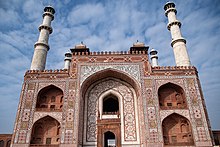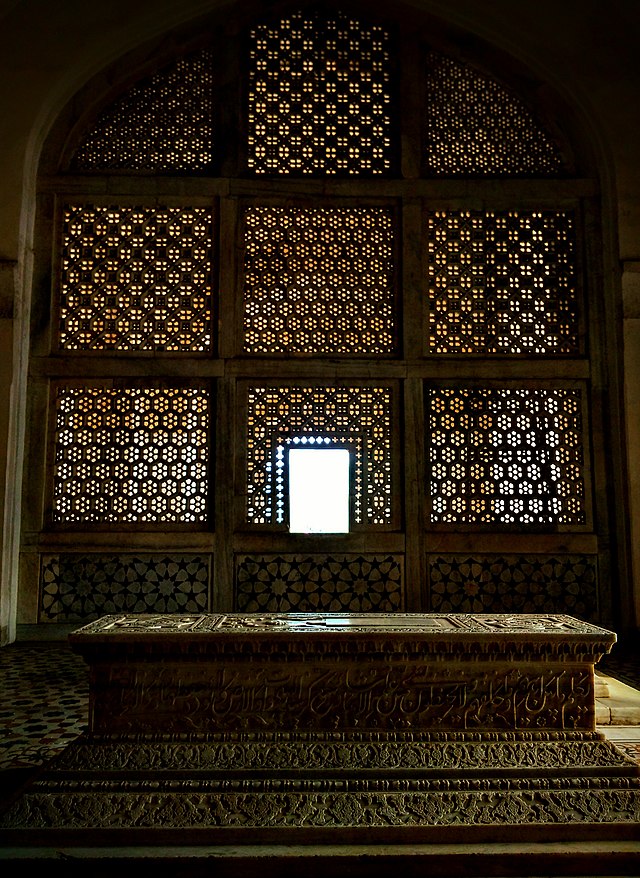Akbar's tomb
Third Mughal Emperor Akbar's tomb From Wikipedia, the free encyclopedia
Third Mughal Emperor Akbar's tomb From Wikipedia, the free encyclopedia
Akbar's tomb is the mausoleum of the third and greatest Mughal emperor Akbar. The tomb was built in 1605–1613 by his son, Jahangir and is situated on 119 acres of grounds in Sikandra, a suburb of Agra, Uttar Pradesh, India. The buildings are constructed mainly from a deep red sandstone, enriched with features in white marble.[1][2]
| Tomb of Akbar | |
|---|---|
 Akbar's tomb of external entrance from the road, built to imitate the Buland Darwaza at Fatehpur Sikri, the city Akbar founded | |
| Religion | |
| Affiliation | Islam |
| District | Sikandra |
| Province | Agra |
| Ecclesiastical or organizational status | Tomb |
| Leadership | Jahangir |
| Year consecrated | 1605 |
| Location | |
| Location | |
| Territory | Sikandra |
| Geographic coordinates | 27°13′14″N 77°57′01″E |
| Architecture | |
| Type | Tomb |
| Style | Mughal architecture |
| Completed | In 1613 |
| Specifications | |
| Direction of façade | Four-tiered pyramid |
| Height (max) | 100 ft |
| Materials | Red Sandstone White Marble |
It is located at Sikandra, in the suburbs of Agra, on the Mathura road (NH2), 8 km west-northwest of the city center. About 1 km away from the tomb, lies, Tomb of Mariam-uz-Zamani, his favourite wife,[3] who after the death of Akbar laid a large garden around his tomb and was later buried there by her son, Jahangir.[4]

Akbar I was the third Mughal emperor, who reigned from 1556 to 1605. Akbar succeeded his father, Humayun, under a regent, Bairam Khan, who helped the young emperor expand and consolidate Mughal domains in the Indian subcontinent.[5][6] Akbar gradually enlarged the Mughal Empire to include much of the Indian subcontinent through Mughal military, political, cultural, and economic dominance. Under Akbar, Mughal India developed a strong and stable economy, which tripled in size and wealth, leading to commercial expansion and greater patronage of an Indo-Persian culture.[7][8] Akbar's courts at Delhi, Agra, and Fatehpur Sikri attracted holy men of many faiths, poets, architects, and artisans, and become known as centres of the arts, letters, and learning.[9]
On 3 October 1605, Akbar fell ill from an attack of dysentery, from which he never recovered. He is believed to have died on 26 October 1605.[10][11] After Akbar's death, his son Jahangir planned and completed the construction of his father's tomb in 1605–1613. It cost 1,500,000 rupees to build and took 3 or 4 years to complete.[12][13]

As Viceroy of India, George Curzon directed extensive repairs and restoration of Akbar's mausoleum, which were completed in 1905. Curzon discussed the restoration of the mausoleum and other historical buildings in Agra in connection with the passage of the Ancient Monuments Preservation Act in 1904, when he described the project as "an offering of reverence to the past and a gift of recovered beauty to the future". This preservation project may have discouraged veneration of the mausoleum by pilgrims and people living nearby.[14]

The south gate is the largest, with four white marble chhatri-topped minarets, which are similar to (and pre-date) those of the Taj Mahal, and is the normal point of entry to the tomb. The tomb itself is surrounded by a walled enclosure 105 m square. The tomb building is a four-tiered pyramid, surmounted by a marble pavilion containing the false tomb. The true tomb, as in other mausoleums, is in the basement.[15]
The buildings are constructed mainly from a deep red sandstone, enriched with features in white marble. Decorated inlaid panels of these materials and a black slate adorn the tomb and the main gatehouse. Panel designs are geometric, floral and calligraphic, and prefigure the more complex and subtle designs later incorporated in Itmad-ud-Daulah's tomb.[16] There are four gateways in the tomb, which were built using red sandstone and design were inlaid using marble. The roof of the gateway has four kiosks. The magnificence of the gateway is inspired by the Buland Darwaza.[17]

Mariam-uz-Zamani, after the death of her husband, Akbar, laid a large garden around his tomb, which originally had an open baradari (pleasure pavilion) built during the reign of Sikander Lodi, in 1495 AD.[4] After her death in May 1623, she was buried here near her husband's tomb and the baradari was converted into a fine mausoleum by her son, Jahangir.[18] She stands as the only wife of Akbar buried closed to him.[19]
The first floor of the tomb, has cloisters on four sides having arches, and has a hall where the tombstone of Akbar lies. The hall also consist tombstones of Shakr-un-Nissa Begum and Aram Banu Begum, the two daughters of Akbar.[20][21]
During the reign of Aurangzeb, Jats rose in rebellion under the leadership of Raja Ram Jat. Mughal prestige suffered a blow when Jats ransacked Akbar's tomb, plundering and looting the gold, jewels, silver, and carpets.[22] The grave was opened and the late king's bones were burned.[23][24] This successful raid followed a previous unsuccessful attempt in 1685 and resulted in an escalation of the conflict between the Mughals and the Jats.[25][26]
Seamless Wikipedia browsing. On steroids.
Every time you click a link to Wikipedia, Wiktionary or Wikiquote in your browser's search results, it will show the modern Wikiwand interface.
Wikiwand extension is a five stars, simple, with minimum permission required to keep your browsing private, safe and transparent.